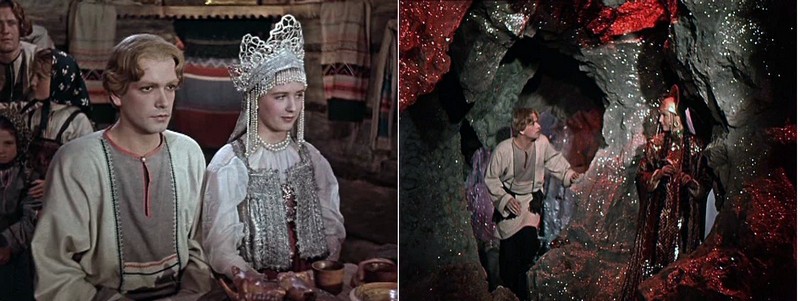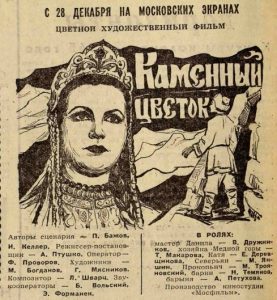
THE SCREEN; ‘Stone Flower,’ a Russian Film With Politics or War, Shown at Stanley With Fine Color Effects
Dec. 30, 1946
As a distinct departure from the spate of Russian films motivated ponderously by war or politics, «Stone Flower,» which had its première at the Stanley on Saturday, is both a pleasant revelation and a tribute to the Soviet filmmakers’ grasp of a difficult medium. For this legend, the first feature picture to be photographed by the Russians in their recently developed color process, pastoral fantasy and shades of the spectrum have been blended to achieve a work of visual beauty. And, though the reported «secret» process is short of perfect and the choice of subject matter not completely intriguing by American box-office standards, «Stone Flower» is sturdy enough to compete with many of Hollywood’s polychromatic offerings.Feodor Provorov’s photography has the faults inherent in the recent short Soviet color documentary, «Russia on Parade,» in that long shots are blurred. But close-up scenes as well as those of sylvan forests and the interior of a fabulous, gem-filled mountain are delicate, natural and strikingly vivid.The story, as directed by Alexander Ptushko, known here for his work on «New Gulliver,» stems from «The Malachite Box.» It is a fireside legend told by an old man to eager youngsters about an apprentice stone carver who fashions a beautiful malachite, flowerlike chalice but feels it is lifeless. Seeking perfection, he leaves his fiancße and follows a sorceress, the Lady of the Cooper Mountain, to her subterranean realm, where he sculps the flower of his dreams. But it is there that he learns that it is his sweetheart’s love he wants. And it is that strong desire which eventually frees him from the mountain.Vladimir Druzhnikov, as handsome as any of the West Coast’s current favorites, makes the stone carver a serious, sensitive and convincing hero, while Elena Derevschikova’s simplicity and beauty as his sweetheart lends itself admirably to the color cameras. And Tamara Makarova, as the beautiful goddess of the mountain, and Mikhail Troyanovsky, as an aged artisan, contribute character and weight to this imaginative and expressive fairy story, which won the top color prize at the International Film Festival at Cannes.
STONE FLOWER, scenario by Pavel Bazhov and Ivan Keller; directed by Alexander Ptushko; a Russian film photographed in color by Feodor Provorov and produced by Mosfilm Studios in Moscow and Prague, with music by Lev Schwartz; released here by Artinko Pictures. At the Stanley 27 December 1946.
Danila . . . . . Vladimir Druzhnikov
Katya . . . . . Elena Derevschikova
Lady of the Copper Mountain . . . . . Tamara Makarova
Prokopich . . . . . Mikhail Troyanovsky
Slishko, the story teller . . . . . Alexander Kleberer
Nobleman . . . . . Nikolal Temyakov
Выпущен на экран 29 апреля 1946 года в московских кинотеатрах: Ударник. Метрополь. Киноактера. Москва, Колизей. Художественный, Центральный, Родина, Форум, Таганский, Орион. Шторм, ЦПКиО им. Горького

Повторный выпуск в СССР 28 декабря 1964 года
Выпуск на экран:
Франция (France) — сентябрь 1946 (Cannes Film Festival)
Финляндия (Finland) — 29.11.1946
Швеция (Sweden) — 02.121946
США (USA) — 27.12.1946
Германия (Germany) — 08.04.1947
Франция (France) — 11.07.1947
Другие названия:
Czarodziejski kwiat (Poland), Fiore di pietra, Il (Italy), Fleur de pierre, La (France), Flor de piedra, La (Argentina), Kivinen kukka (Finland), Petrino louloudi, To (Greece), Steinerne Blume, Die (Austria), Stenblomman (Sweden), The Stone Flower (USA)
| ФИЛЬМОГРАФИЯ ОТЕЧЕСТВЕННЫХ ФИЛЬМОВ |



